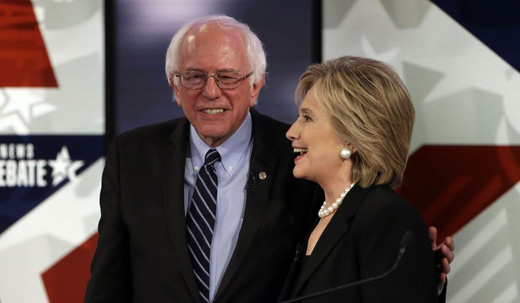
The Democratic presidential primaries held yesterday in five Northeastern states can be summed up as “same old, same old.” More exciting is the fact that despite some recent acrimony borne of media-fanned campaign fever, Bernie Sanders and Hillary Clinton are keeping their eyes on building a wall to protect the White House from being captured by right wingers.
Yesterday, Clinton won in Pennsylvania, Delaware and Maryland and squeaked out a victory in Connecticut. Sanders won in Rhode Island. However, all Democratic primaries award delegates proportionally, so when all was said and done, Clinton’s lead over Sanders remained about the same.
Meanwhile, conversations have begun about blending Sanders’ political revolution with Clinton’s more traditional political campaign.
It will require some give and take.
Republican Party danger
The Republicans also held primaries yesterday in the same states as did the Democrats. Donald Trump swept the field.
In her speech last night, Clinton said that if the Republicans win the White House they will take more rights away from the American people.
“We will unify our party to win this election,” she said. “No matter if you support me or Senator Sanders, there is much more that unites us than divides us.”
Beating whoever the Republicans finally put up for election might not be easy. For example, the Harrisburg, Pennsylvania, Patriot-News reported that more than 60,000 Democrats in Pennsylvania switched to the Republican Party recently. The paper says that in large part the switching was due to “Donald Trump’s appeal to working-class, blue collar workers.”
Moreover, the majority of these voters said they will support whoever is the Republican nominee. One of the biggest challenges to those who are truly pro-worker is to convince working people like those in Pennsylvania that they are being misled into voting against their own interest.
All the Republican candidates are against Obamacare, the IRS, the EPA, and any other government agency or policy that endeavors to stop corporations from completely running roughshod over the American people.
Democratic Party dynamics
Every poll among the general public shows that Sanders could beat both Trump and Ted Cruz in the general election by more votes than Clinton. They also show Sanders beating John Kasich while Clinton would lose to him.
Polls also indicate that Sanders could eat into Trump’s hold on blue collar workers.
Further, every poll shows Clinton having a very high unfavorability rating among the general public and Sanders’ having the highest favorability rating of all candidates, Democratic or Republican. (By the way, polls show that Trump has the highest unfavorability rating in the history of polls.)
So why is it that Clinton has won over 300 more delegates than Sanders in primaries and caucuses and has more than ten times the number of super delegates? (Super delegates are Democratic elected officials and party leaders who can support whoever they wish to, regardless of how their constituents vote in primaries or caucuses.)
Why the disconnect between electability in the general election and votes in primaries and caucuses? It’s because internal party dynamics play a huge role in primaries and caucuses.
Bill and Hillary Clinton have helped many of the men and women who are now super delegates get elected to public office.
Furthermore, the Clintons are funneling money into the campaigns of down ballot Democratic candidates through the Hillary Victory Fund, which is run jointly by the Clinton campaign and the Democratic National Committee itself.
No wonder that even though super delegates can change their allegiance at will, almost none have switched from Clinton to Sanders.
Moreover, right now, Clinton’s delegate count almost assures her of clinching the nomination.
Democratic Party leaders feel that despite the polls, Hillary’s message of “I know the presidential ropes. I can get things done” will triumph over any candidate that the Republicans throw against her.
Let’s hope they’re right.
Democratic Party leaders are counting on enlisting Sanders supporters into the Clinton campaign. They would bring with them much needed enthusiasm and energy. Also, Clinton needs the support of the millennials and trade unionists now working for Sanders.
Furthermore, if Clinton is elected, to accomplish anything she’ll need strong organizations on the ground to elect Democrats to the House and Senate and to wrest control of governorships away from incumbent right wingers.
Building a progressive movement
As news analyst Alex Seitz-Wald points out, “Sanders has always been as much a movement leader as he is a politician and hundreds of volunteer groups have sprouted up organically across the country …”
These groups are already talking about joining with others to build a progressive movement that will continue to influence federal, state and local politics for years to come. For her part, Clinton is beginning to reach out to this movement.
Here’s the rub: the Clinton political campaign is organized like … well, a political campaign. Whereas the Sanders campaign is more like an organizing drive, with grassroots leaders across the country bringing people together to fight at every level of government for a wide range of progressive goals.
Sanders has already assured the Democratic Party that he will support Clinton if she wins the nomination.
However, meshing Sanders’ political revolution with Clinton’s run for the presidency will take more than a nod from Sanders. It will take Clinton winning over the political revolution’s grassroots leaders by encompassing their goals.
She has begun to do this.
Jeff Weaver, Sanders’ campaign manager, recently wrote: “Our political revolution has already forced a former U.S. Senator and Secretary of State to change her mind on matters as critical as international trade, the Keystone Pipeline and the federal minimum wage.”
Win or lose, Sanders is determined to go to the Democratic National Convention in July with as many delegates as possible pledged to support reforms within the Democratic Party and strong progressive planks in the Democratic Party platform.
One reform might be to do away with super delegates to assure that candidates have the support of the rank and file. Another might be to open up primaries to all and not restrict them to registered Democrats. The balloting would then reflect the will of the general public and lessen the role of internal party politics.
The Sanders delegates will also go to the Convention to fight for a platform that includes universal health care, the speedy development of sustainable energy sources, raising the minimum wage to $15 an hour, debt-free higher education, breaking the hold Wall Street has on our economy, criminal justice reform and campaign finance reform.
An indication that the goals of the political revolution might be adopted as planks in Democratic Party platform is that in her speech last night, Clinton listed them as her own.
Even if the Democratic Party platform includes all the goals of the political revolution, history shows that there is a rather loose correlation between what’s in a platform and what candidates actually do when elected.
For that reason, there are discussions across the country to create a new political movement that would hold elected officials accountable and that would actually help them accomplish progressive goals.
For example, according to Alex Seitz-Wald, an organization called People for Bernie is scheduled to hold a two-day People’s Summit in mid-June between the final set of primaries and the Democratic National Convention in late July.
“There’s a vibrant conversation going on about what happens to the movement after the primaries are over,” said Charles Lenchner, People for Bernie co-founder. ‘[There are] a collection of groups that share a lot in common and want to work together in the future and who represent a significant portion of the coalition that has come together around Bernie Sanders.”
The first focus of the new group will probably be the upcoming general election, according to Seitz-Wald.
Aside from People for Bernie, these groups include the National Nurses United union, the environmental group 350.org, the Progressive Democrats of America and the Democratic Socialists of America.
In addition, at a recent Labor for Bernie meeting in Chicago, Peter Olney, former organizing for the Longshore and Warehouse Union called for “unions that have embraced Bernie and the call for political revolution to stick together …”
Leaders of both People for and Labor for are determined to work within the current political landscape, but want to avoid what happened to Organizing for America, a grassroots group initiated by President Obama. It withered when the Democratic Party withdrew its funds.
To build a progressive movement that can sustain itself, Olney said at the Labor for Bernie meeting, “[unions and other groups must] agree to provide sufficient resources to coordinate our work.
“It will require,” Olney concluded, “union leadership forming a coordinating body and staff to begin implementing a unifying program in selected campaigns at the state and national level.”
Photo: Charlie Neibergall/AP










